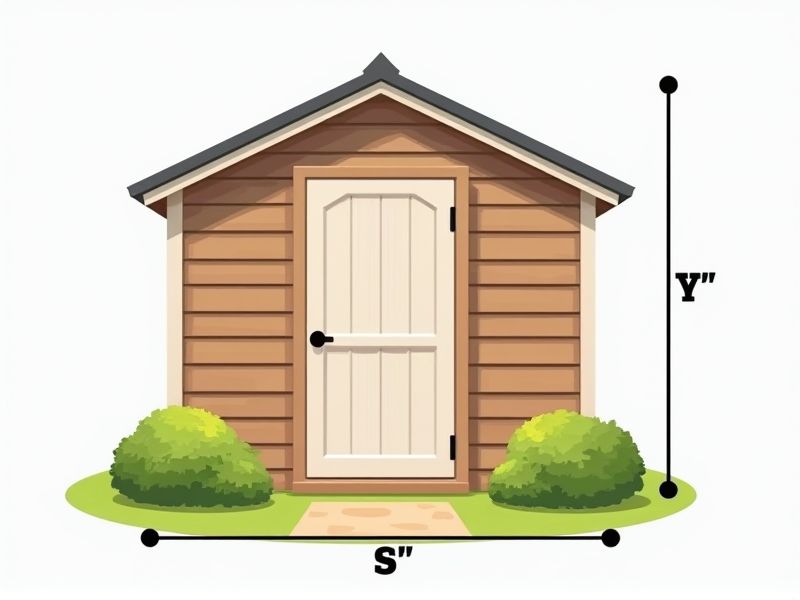
When planning a garden shed, knowing the standard dimensions can help you make the most of your available space. Typically, common sizes for garden sheds range from 6x4 feet for compact storage to 8x6 or 10x8 feet for larger gardening tools and equipment. Consider measuring your outdoor area and listing what items you want to store before choosing a size. Selecting the right shed dimensions ensures you maximize storage, keep your garden organized, and avoid overcrowding your space.
Width Options From 4 To 14 Feet
Garden sheds typically span widths ranging from 4 to 14 feet, allowing for a variety of storage and workspace needs. A 4-foot width is ideal for compact spaces, perfect for storing tools or gardening supplies, while a 14-foot option provides ample space for larger equipment or workshop activities. Choosing the right width ensures a fit for your garden design and functionality requirement. When considering your options, measure your available area to maximize efficiency and accessibility in your outdoor space.
Length Options From 6 To 20 Feet
Garden sheds are available in various lengths, with options ranging from 6 feet to 20 feet, allowing you to select the perfect size for your outdoor space. A 6-foot garden shed provides a compact solution for storage of tools, while a 20-foot shed offers extensive room for larger equipment or even a small workshop. Choose a length that fits your specific storage needs and complements your landscape design. Understanding these dimensions is essential for maximizing the utility of your garden shed.
Common Sidewall Height Of 6 To 9 Feet
A common sidewall height for garden sheds typically ranges from 6 to 9 feet, providing adequate headroom and accessibility for various gardening tools and equipment. This height facilitates efficient utilization of vertical space, enabling you to store larger items or install shelving units. Many homeowners opt for sheds within this range to enhance both practicality and aesthetic appeal in their backyards. Selecting a sidewall height that aligns with your gardening needs can significantly improve your shed's functionality.
Roof Pitch Angle For Water Runoff
Roof pitch angles of garden sheds are crucial for effective water runoff, with the ideal range typically between 15 to 30 degrees. A steeper pitch reduces the likelihood of water pooling, minimizing the risk of leaks and structural damage. Properly designed roof angles can improve the durability of the shed, ensuring that it withstands harsh weather conditions. Maintaining this standard can extend its lifespan, allowing you to enjoy your garden shed for years to come.
Door Height For Easy Access
A standard garden shed typically features a door height of at least 6 feet 8 inches, ensuring easy access for individuals of varying heights. This measurement allows most users to enter without the need to crouch or bend, enhancing comfort and convenience. Additionally, the door width often ranges from 3 to 4 feet, accommodating bulkier gardening tools and equipment effortlessly. When selecting your garden shed, prioritizing these dimensions will significantly improve usability and functionality.
Overhang Dimensions For Protection
The ideal overhang dimensions for a garden shed typically range from 12 to 24 inches, providing optimal protection against rain and sun exposure. A well-designed overhang not only shields the walls and door from water damage but also enhances ventilation, preventing moisture buildup. Proper installation of overhangs can lead to extended longevity of your shed materials, allowing for up to a 30% increase in durability. Consider evaluating your local climate conditions to determine the best overhang size for your specific needs.
Window Placement For Ventilation
When designing a garden shed, optimal window placement is crucial for effective ventilation. Positioning at least two windows on opposite walls can create cross-ventilation, enhancing airflow throughout the space. Windows should be strategically sized; for example, a 3-foot by 3-foot window allows ample light while promoting air circulation. By prioritizing these elements, you ensure a healthier environment for your gardening tools and supplies, minimizing humidity and mildew risks.
Shed Foundation Depth Measurements
A proper garden shed foundation ensures stability and longevity, with a recommended depth ranging from 4 to 6 inches for concrete bases. If you're using gravel or pavers, aim for a depth of 3 to 4 inches to provide adequate drainage and support. For regions with frost, a depth of at least 12 inches may be necessary to prevent heaving during freeze-thaw cycles. You should always check local building codes, as they may dictate specific foundation requirements based on soil type and climate.
Distance From Property Lines
When planning your garden shed, ensure it is strategically placed at least 5 to 10 feet away from property lines to comply with local zoning laws. This distance helps avoid potential disputes with neighbors and maintains a clear boundary around your property. You should also check specific regulations, as some areas may require even greater setbacks based on the size of the shed or local ordinances. Proper positioning not only protects your interests but can enhance the aesthetic appeal of your garden.
Compliance With Local Building Codes
Compliance with local building codes is crucial when constructing a garden shed, as these regulations ensure safety, durability, and neighborhood harmony. Depending on your location, you may need to address height restrictions, setback requirements, and structural materials mandated by authorities. Typically, you might also need a permit for sheds exceeding a certain size, often around 120 square feet, to ensure they meet zoning laws. By prioritizing these codes, you can enhance the longevity of your shed while increasing the value of your property.
